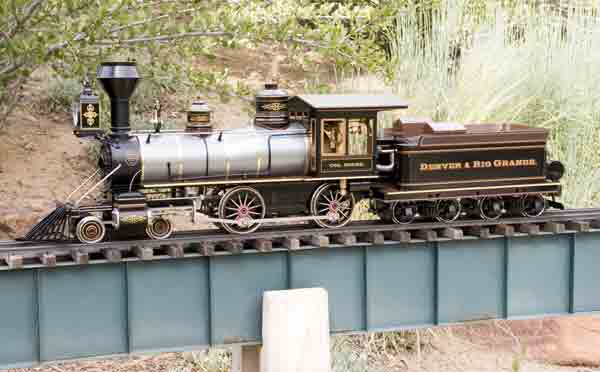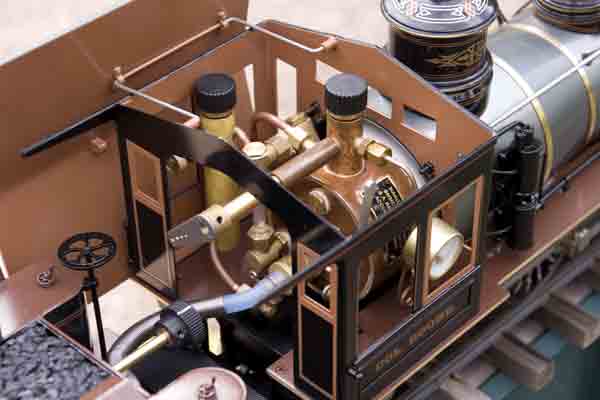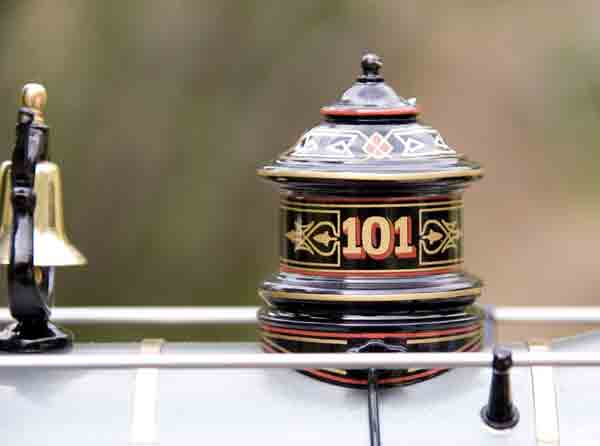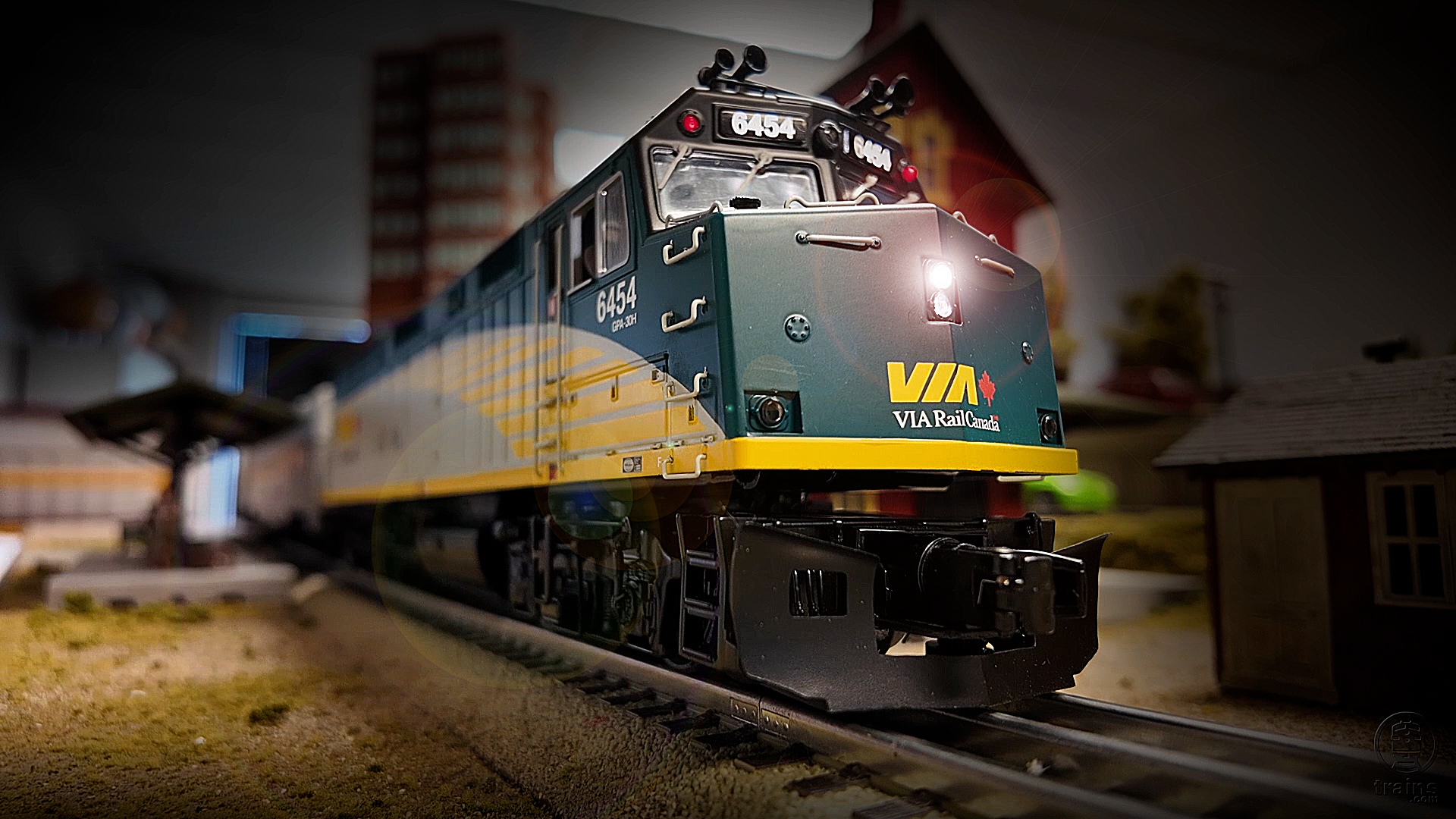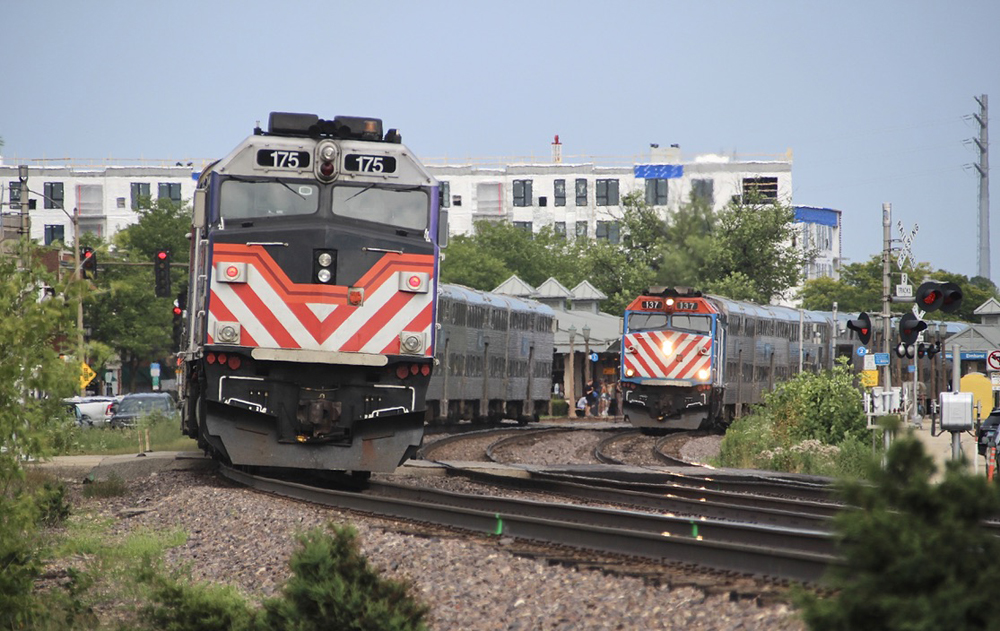1:20.3 scale, gauge 1, live-steam 4-4-0
Accucraft
33268 Central Avenue
Union City CA 94578
Price: $1,895
Web site: www.accucraft.com
All metal, live-steam model of a Baldwin 4-4-0; sprung chassis; sprung tender trucks; fittings include throttle, safety valve, water glass, pressure gauge, lubricator; single-flue boiler; butane fired; simple-eccentric-with-reversing-link reversing, controlled from the cab; painted and lettered; some minor assembly required; instructions included. Dimensions: length (loco and tender) 25½”; width, 4¾”; height, 75/8″. In 1:20.3, this works out to 43’2″ x 8’0″ x 12’11”, respectively
Pros: Well-constructed model; excellent running characteristics; clearly audible chuff; excellent paint and ornate graphics; nice array of backhead fittings; large boiler and fuel tank; easy to control; can be radio controlled; clearly captures the spirit of the prototype; correct scale/gauge combination; tool kit and instructions supplied
Cons: Toy-type safety valve; lubricator drain is fouled by adjacent dummy tank; throttle is difficult to reach under the cab roof on the fly; no hand pump in tender; unsightly fuel line to locomotive; no spark arrestor in top of stack
Accucraft’s model is a typical narrow-gauge Baldwin locomotive of the era. Although based on the South Pacific Coast Railroad’s Nº 3, it is offered in several road names and paint schemes. Our review sample is decorated for the Denver & Rio Grande. The paint, lettering, and lining is ornate and very well done. Lettering and lining appear to be decals, and they are everywhere-on the domes, the dummy headlight, the wheels, the tender, and the cab-making this a very attractive locomotive. The engine’s drivers are light and airy. Between the drives is the large, dummy firebox.
Some assembly was required before the engine was run. This included installing the pilot, cab and tender steps, and the dummy safety valves and whistle on the steam dome. All necessary tools for this are supplied.
The locomotive is gas fired, with a standard, single-flue boiler. The fuel is carried in a relatively large tank in the tender, under the dummy, lift-out coal load. The tender can also carry water, not for the boiler, but to keep the fuel tank warm and happy during cold weather. It is a shame that a hand pump has not been fitted to this engine, but that seems typical with Accucraft. It could be a valuable accessory. Fuel is transported from the valve on the tank to the jet in the burner by a silicone fuel line wrapped in a spring. This is fairly large and is an eyesore between the engine and tender. A resourceful modeler might be able to reroute it. The jet is attached to the end of the fuel line and simply snaps into the burner in the boiler’s backhead.
Boiler fittings include a pressure gauge and a water glass. The throttle on our review sample came with a lever that could be used for radio control. Also supplied was a knob that could be used to replace the lever, though why anyone would give up a lever in favor of a knob is beyond me. A reversing quadrant resides on the right side of the cab. It has notches for full forward, full reverse, and neutral. The valve gear, which is unusually driven off the second axle, is simple-eccentric with reversing link. The prototype would have had Stephenson’s gear.
Also in the cab is a large displacement lubricator. Accucraft has added a control valve to the lubricator that can be used to control the amount of oil traveling to the cylinders. This might be useful in cold weather. On the bottom of the lubricator is a drain valve, which, the instructions suggest, can be used as a blowdown. Due to the proximity of an adjacent dummy tank, the tiny valve is difficult to reach and actuate.
The boiler has a safety valve set to blow off at 40 psi. Upon removing the steam dome, I found that the valve was a simple, toy-type safety valve. Although it works well enough, it weeps and hisses before finally letting go at 40 pounds. A locomotive of this caliber should really be fitted with a proper pop-type safety.
Steam trials were conducted on a warm summer evening. The engine was prepared in the usual way, according to the directions. The water glass made it easy to fill the boiler with the proper amount of water. The cab roof lifts off to one side for access to the controls. There’s a filler plug in the cab, so you needn’t remove any of the domes. I opened the smokebox door, cracked the fuel valve, and lit the fire, which immediately flashed back into the flue where it belonged. Pressure was up to 20 pounds in around eight minutes, and up to 40 in a couple more. I opened the throttle and let the engine clear its condensate without pushing it. This it did in just a few revolutions of the drivers. After that, it was off and running, with the exhaust beat audible over the roar of the burner. It ran smoothly and strongly in both directions. I found access to the throttle to be with the cab roof in place, making adjustments on the fly a little problematic.
For sustained, faster running, I found it necessary to increase the fuel to the burner. This, of course, will shorten the run, but a strong, fast run is certainly possible with this engine. On the other hand, running at a sedate speed with 20 pounds on the clock is also easy and enjoyable. The run lasted a solid half hour, when the water reached the bottom of the glass. I shut it down then, although it probably would have run for another five or 10 minutes. I didn’t want to risk running the boiler dry.
This fine-running locomotive is relatively simple to operate, but there is enough to it to keep it interesting, and it is a joy to watch sailing around the track, lap after lap. If you have a taste for early American steamers, this is definitely one to consider.





